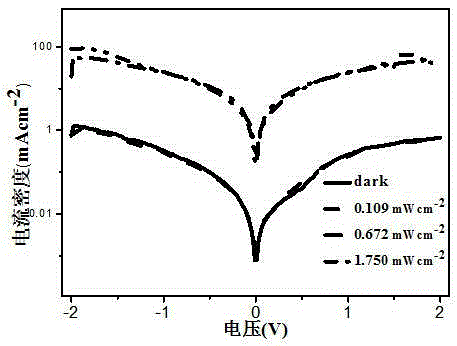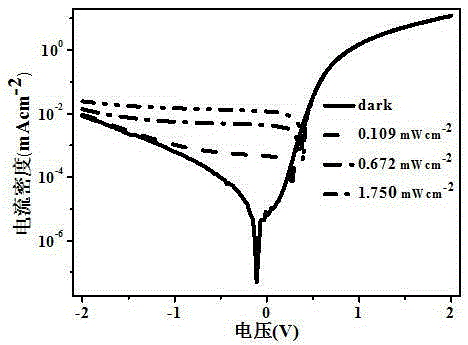Near-infrared visible-light OPV iodine-doped photovoltaic organic detector
A visible light and near-infrared technology, applied in the field of optoelectronics, can solve the problems of not many, very little photosensitive layer of infrared detectors, no photoactivity, etc., and achieve the effects of controllable performance, considerable market prospects, and outstanding novelty.
- Summary
- Abstract
- Description
- Claims
- Application Information
AI Technical Summary
Problems solved by technology
Method used
Image
Examples
Embodiment 1
[0023] Example 1, such as Figure 1-6 Shown:
[0024] An OPV iodine-doped photovoltaic organic detector for near-infrared and visible light, composed of various functional layers arranged on a substrate, including a substrate 1, a metal or transparent conductive electrode 3, a hole transport layer 4 and an organic photosensitive layer 2 etc., substrate 1, prepare metal or transparent conductive electrode 3 by magnetron sputtering or electron beam evaporation on the substrate, spin-coat hole transport layer 4 on the transparent conductive electrode, and then spin-coat organic material on the hole transport layer. The photosensitive layer 2, and finally the upper metal electrode 3 is prepared on the photosensitive layer by electron beam evaporation.
[0025] The material of the substrate 1 in the present invention is cheap glass.
[0026] Concrete preparation process is as follows:
[0027] (1) Deposit an ITO film of about 180nm by magnetron sputtering on a glass substrate; ...
Embodiment 2
[0038] A kind of near-infrared broad-spectrum detector, its preparation process is compared with embodiment 1, this method except the change of the doping mode of iodine, other do not change, such as doping mode is:
[0039] The incorporation of iodine in the OPV material does not use the photosensitive material directly mixed into the OPV, but after spin-coating to obtain a uniform undoped photosensitive layer, weigh 10 mg of iodine, and put the iodine of this mass into In a petri dish, heat it on a heating plate with a temperature of 150°C, place the undoped substrate with a photosensitive layer directly on the petri dish at a certain distance, the area of the substrate is 2.5cm×2.5cm, Under the volatilization of iodine, it can be processed until the iodine vapor volatilizes completely. Afterwards, it was treated in a furnace at a temperature of 150° C. for 15 minutes, and then a metal Al electrode was prepared by an electron beam method, so that a near-infrared detector w...
PUM
 Login to View More
Login to View More Abstract
Description
Claims
Application Information
 Login to View More
Login to View More - R&D
- Intellectual Property
- Life Sciences
- Materials
- Tech Scout
- Unparalleled Data Quality
- Higher Quality Content
- 60% Fewer Hallucinations
Browse by: Latest US Patents, China's latest patents, Technical Efficacy Thesaurus, Application Domain, Technology Topic, Popular Technical Reports.
© 2025 PatSnap. All rights reserved.Legal|Privacy policy|Modern Slavery Act Transparency Statement|Sitemap|About US| Contact US: help@patsnap.com



